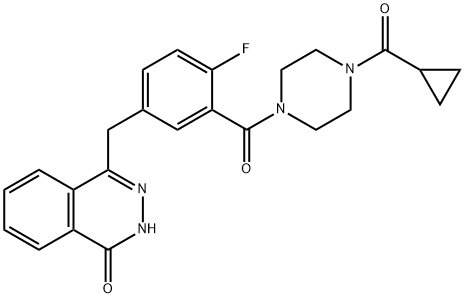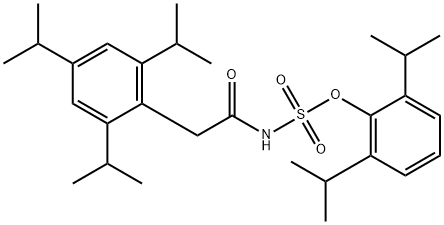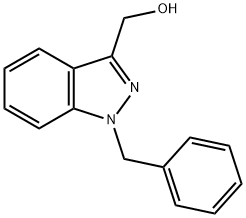Bindarit
- CAS NO.:130641-38-2
- Empirical Formula: C19H20N2O3
- Molecular Weight: 324.37
- MDL number: MFCD00866723
- SAFETY DATA SHEET (SDS)
- Update Date: 2024-07-02 08:55:39

What is Bindarit?
Description
Bindarit is an inhibitor of monocyte chemoattractant protein (MCP) production that is selective for MCP-1/CCL2, MPC-3/CCL7, and MCP-2/CCL8 over other chemokines. It inhibits LPS- or C. albicans-induced production of MCP-1/CCL2 in isolated human monocytes (IC50s = 172 and 403 μM, respectively). Bindarit downregulates NF-κB signaling and prevents p65 and p65/p50-mediated MCP-1/CCL2 promoter activation in RAW264.7 cells. It delays the onset of proteinuria and prolongs survival in a mouse model of experimental lupus nephritis when administered at a dose of 50 mg/kg. It prevents LPS-induced increases in MCP-1/CCL2 expression in mouse brain and spinal cord when administered at a dose of 200 mg/kg and reduces the incidence and severity of experimental autoimmune encephalomyelitis (EAE) in mice. Bindarit is also a noncompetitive inhibitor of monocarboxylate transporter 4 (MCT4; Ki = 30.2 μM for the human transporter) that is selective for MCT4 over MCT1.
The Uses of Bindarit
Bindarit shows anti-inflammatory activity due to a selective inhibition of a subfamily of inflammatory chemokines. Bindarit is a also protein antidenaturant agent. Bindarit modulates the NFkB pathway and has been shown to reduce secondary phase of adjuvant arthritis in rats.
The Uses of Bindarit
Bindarit exhibits selective inhibition against monocyte chemotactic proteins MCP-1/CCL2, MCP-3/CCL7 and MCP-2/CCL8.
Properties of Bindarit
| Boiling point: | 542.9±40.0 °C(Predicted) |
| Density | 1.18±0.1 g/cm3 (20 ºC 760 Torr) |
| storage temp. | 2-8°C |
| solubility | DMSO:47.0(Max Conc. mg/mL);144.89(Max Conc. mM) |
| form | A crystalline solid |
| pka | 3.59±0.10(Predicted) |
| color | White to off-white |
Safety information for Bindarit
| Signal word | Warning |
| Pictogram(s) |
 Exclamation Mark Irritant GHS07 |
| GHS Hazard Statements |
H302:Acute toxicity,oral H315:Skin corrosion/irritation H319:Serious eye damage/eye irritation H335:Specific target organ toxicity, single exposure;Respiratory tract irritation |
| Precautionary Statement Codes |
P261:Avoid breathing dust/fume/gas/mist/vapours/spray. P280:Wear protective gloves/protective clothing/eye protection/face protection. P301+P312:IF SWALLOWED: call a POISON CENTER or doctor/physician IF you feel unwell. P302+P352:IF ON SKIN: wash with plenty of soap and water. P305+P351+P338:IF IN EYES: Rinse cautiously with water for several minutes. Remove contact lenses, if present and easy to do. Continuerinsing. |
Computed Descriptors for Bindarit
New Products
Tert-butyl bis(2-chloroethyl)carbamate 4-Methylphenylacetic acid N-Boc-D-alaninol N-BOC-D/L-ALANINOL 3-Morpholino-1-(4-nitrophenyl)-5,6-dihydropyridin- 2(1H)-one Furan-2,5-Dicarboxylic Acid Tropic acid DIETHYL AMINOMALONATE HYDROCHLORIDE 1,1’-CARBONYLDIIMIDAZOLE R-2-BENZYLOXY PROPIONIC ACID 1,1’-CARBONYLDI (1,2-4 TRIAZOLE) N-METHYL INDAZOLE-3-CARBOXYLIC ACID (2-Hydroxyphenyl)acetonitrile 4-Bromopyrazole 5-BROMO-2CYANO PYRIDINE 5,6-Dimethoxyindanone 5-broMo-2-chloro-N-cyclopentylpyriMidin-4-aMine 2-(Cyanocyclohexyl)acetic acid 4-methoxy-3,5-dinitropyridine 2-aminopropyl benzoate hydrochloride 1-(4-(aminomethyl)benzyl)urea hydrochloride diethyl 2-(2-((tertbutoxycarbonyl)amino) ethyl)malonate tert-butyl 4- (ureidomethyl)benzylcarbamate Ethyl-2-chloro((4-methoxyphenyl)hydrazono)acetateRelated products of tetrahydrofuran








You may like
-
 Bindarit CAS 130641-38-2View Details
Bindarit CAS 130641-38-2View Details
130641-38-2 -
 1975-50-4 98%View Details
1975-50-4 98%View Details
1975-50-4 -
 2-HYDROXY BENZYL ALCOHOL 98%View Details
2-HYDROXY BENZYL ALCOHOL 98%View Details
90-01-7 -
 2-Chloro-1,3-Bis(Dimethylamino)Trimethinium Hexafluorophosphate 221615-75-4 98%View Details
2-Chloro-1,3-Bis(Dimethylamino)Trimethinium Hexafluorophosphate 221615-75-4 98%View Details
221615-75-4 -
 61397-56-6 CIS BROMO BENZOATE 98%View Details
61397-56-6 CIS BROMO BENZOATE 98%View Details
61397-56-6 -
 14714-50-2 (2-Hydroxyphenyl)acetonitrile 98+View Details
14714-50-2 (2-Hydroxyphenyl)acetonitrile 98+View Details
14714-50-2 -
 118753-70-1 98+View Details
118753-70-1 98+View Details
118753-70-1 -
 733039-20-8 5-broMo-2-chloro-N-cyclopentylpyriMidin-4-aMine 98+View Details
733039-20-8 5-broMo-2-chloro-N-cyclopentylpyriMidin-4-aMine 98+View Details
733039-20-8